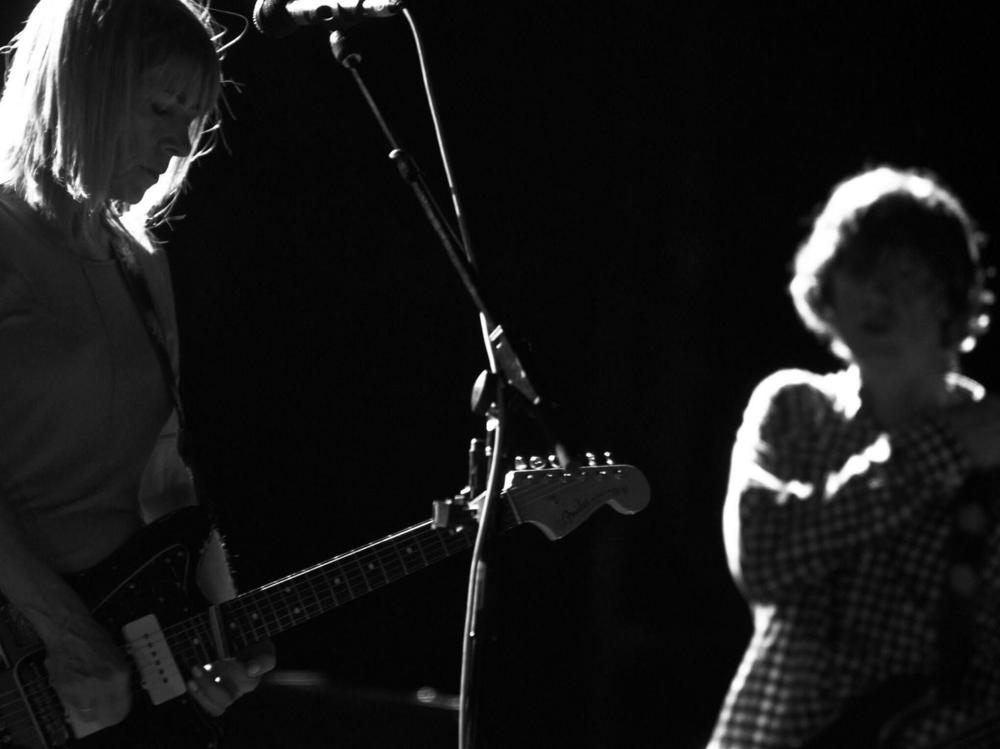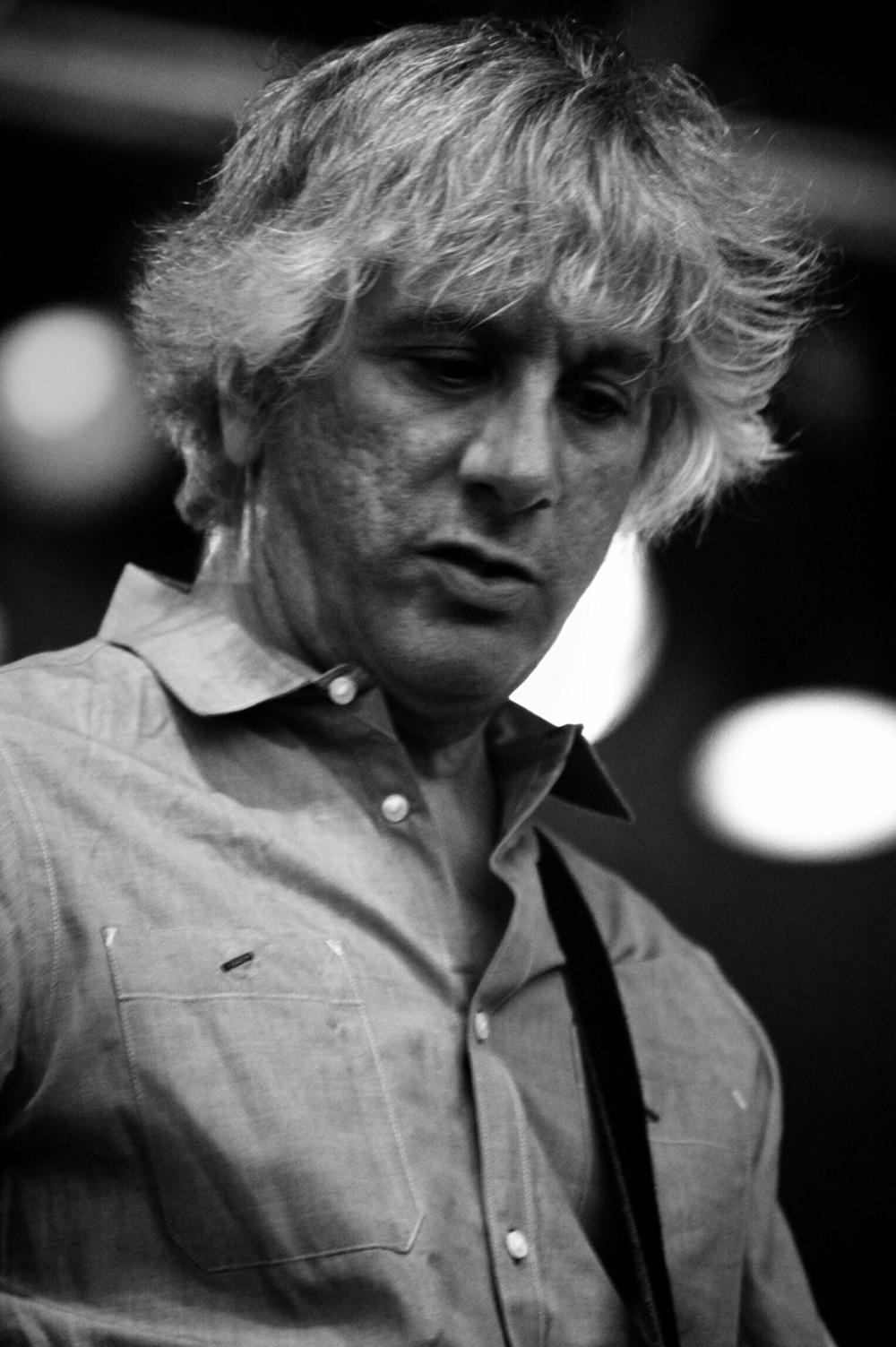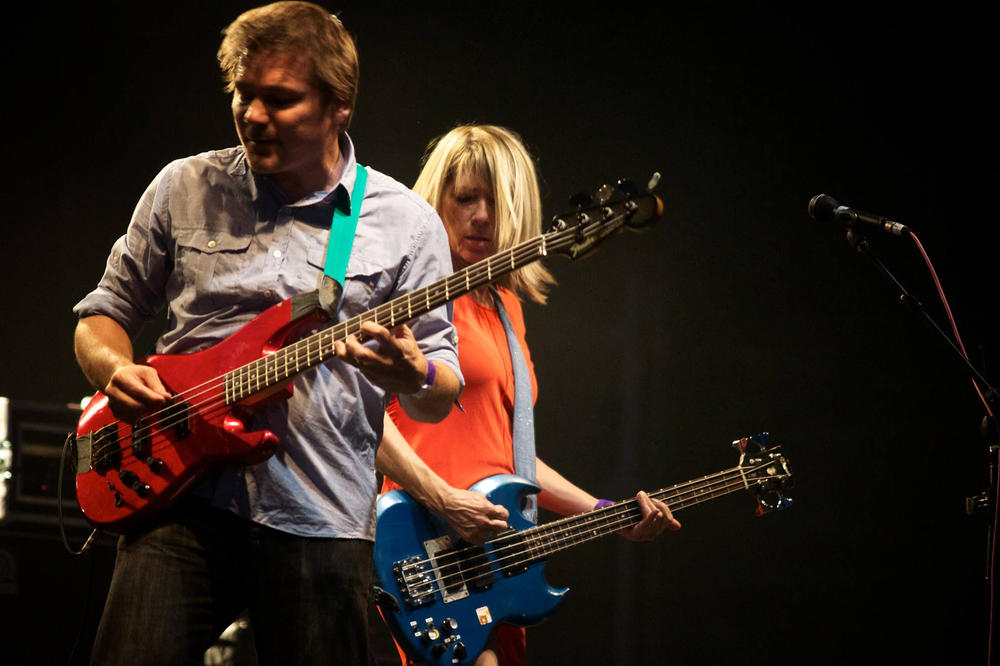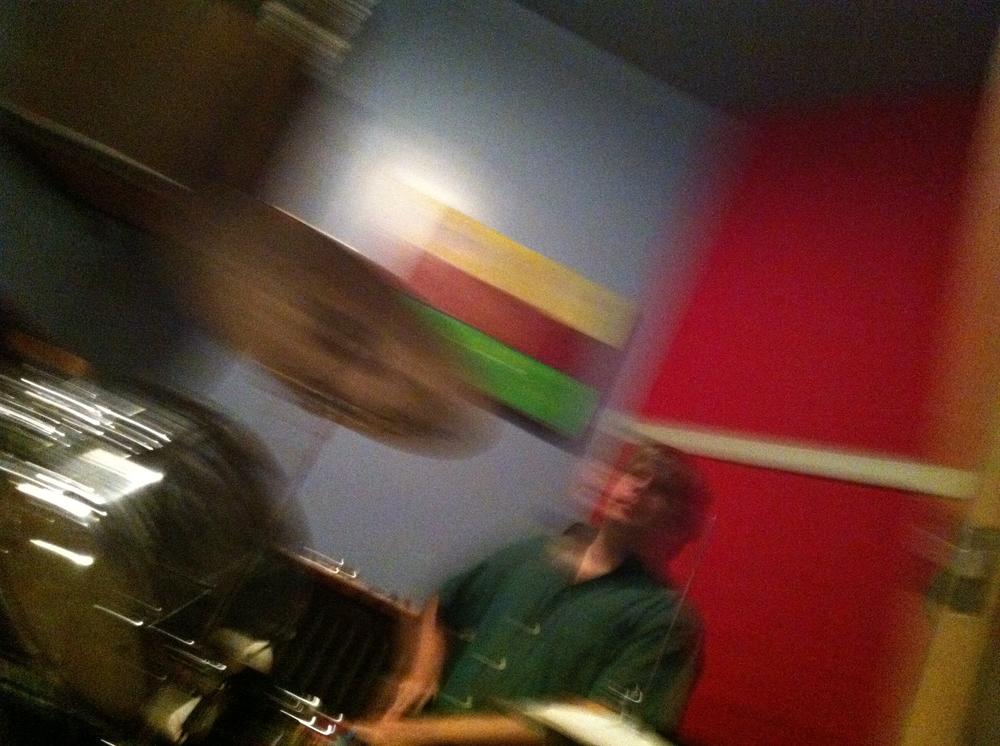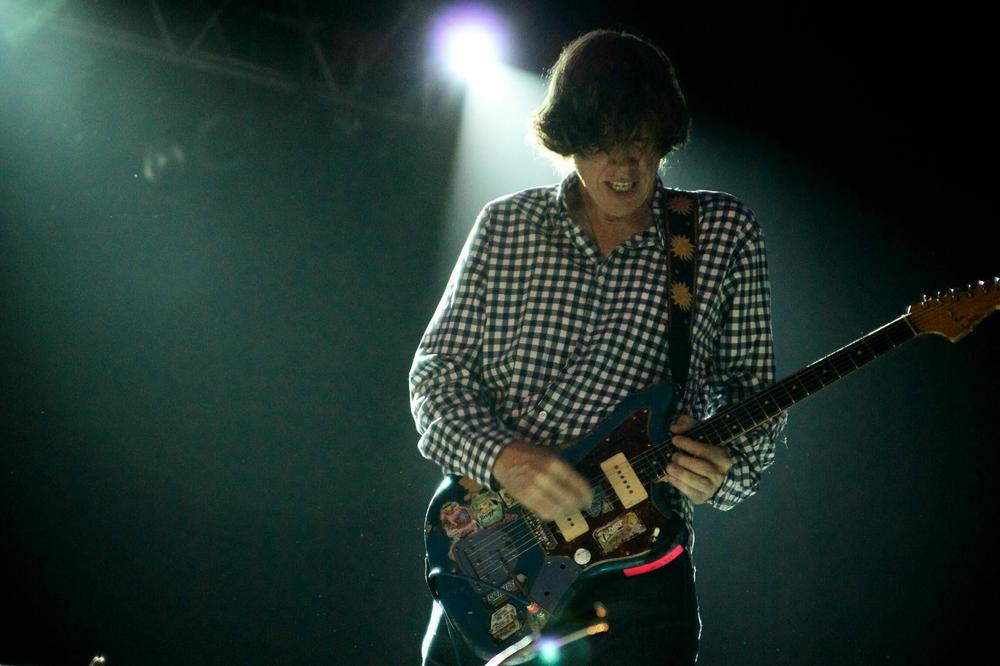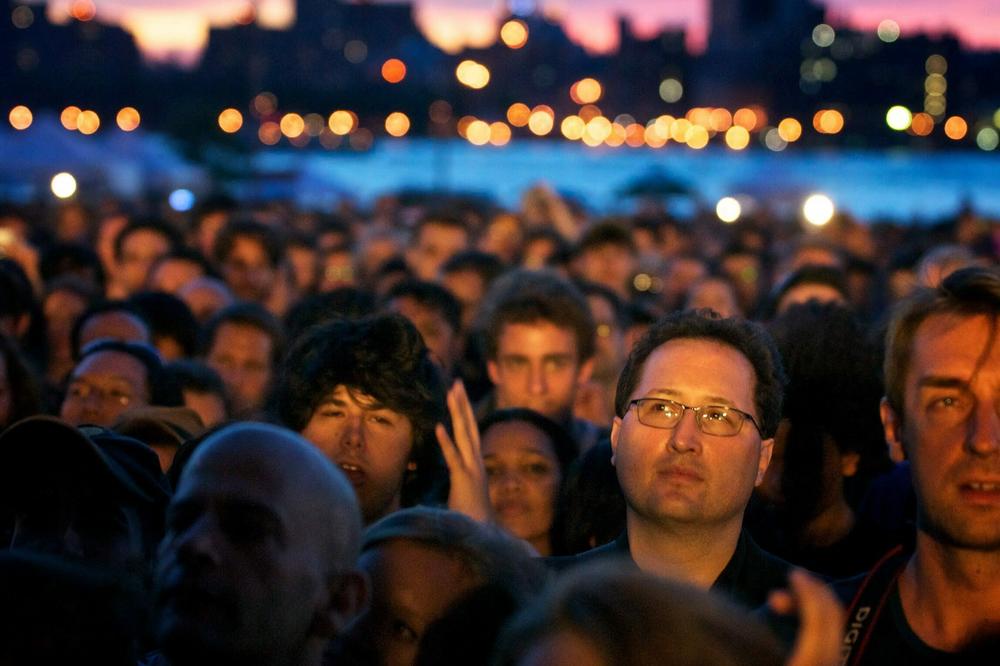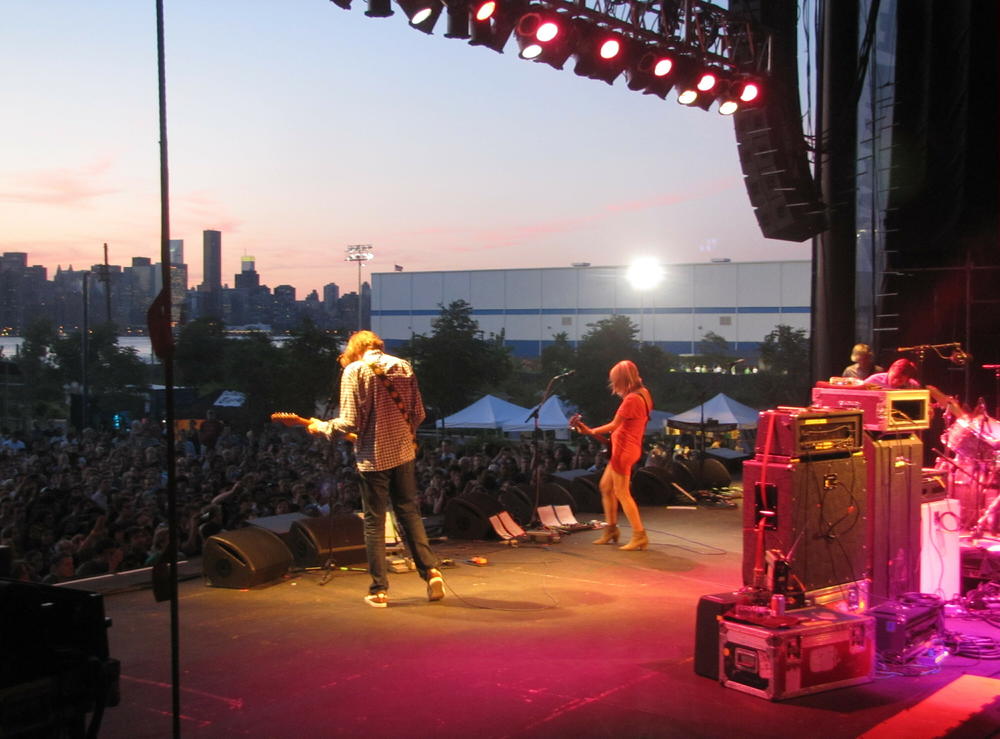Section Branding
Header Content
The sunset of Sonic Youth: An oral history of the band's final U.S. show
Primary Content
No one knew Sonic Youth was making its last stand — not even Sonic Youth itself.
"It was a period of regrouping. But in spite of some personal problems, it was still business as normal: 'We're going out to do a summer show in our hometown,' " admits co-founder Lee Ranaldo from his New York apartment.
This cycle was not either for Sonic Youth or its fans: Despite a period of relative inactivity, with nearly no shows in eight months, most members of one of American indie rock's most beloved, raucous and best bands assumed they'd be back to work soon enough. Their Friday night show on a sprawling outdoor stage alongside the East River in Brooklyn on Aug. 12, 2011, was simply the latest in their decadelong string of summertime New York sets. They had, as always, recruited an excellent cast of openers: Kurt Vile & the Violators, the emerging pride of Philadelphia, and Wild Flag, a Sleater-Kinney offshoot still a month from releasing its debut LP. Sensing nothing unordinary, especially that they were on the precipice of the end, the band issued only one photo pass to a short-lived New York music blog.
But two months and two days after that concert, the night would become the stuff of legend and history, not only for an unorthodox set list where Sonic Youth performed several songs for the first time in decades but also because it was, indeed, the end. The personal problems Ranaldo sensed exploded into public view: After three decades as bandmates and 27 years of marriage, Kim Gordon and Thurston Moore — the first couple of indie rock, a pair whose creative partnership had given countless Gen X disciples life goals — were splitting. With their marriage's fracture, the band would also end. In the years to come, through interviews and memoirs and gossip columns, the source of that split would become clear: a common middle-aged affair.
Sonic Youth played five more shows that November, fulfilling a contractual obligation for a festival swing through South America. Those were hard and perfunctory gigs, so that night in Brooklyn remained special. "I always refer to it as the last show, because it was the last one where we weren't cognizant that we were going to stop playing," says Ranaldo, sighing. "There's a lot of complicated feelings in the aftermath, but we all left that concert feeling like we did a wonderful job."
For that final moment, at least, Sonic Youth's future seemed wide open. As Rose Flag, a superfan who had driven down that day from western Massachusetts, reckoned of the night: "Sonic Youth had lasted 30 years, so what was another 30 years?"
This week, Silver Current Records will release a remixed version of the concert, previously issued online as a pandemic-era Bandcamp exclusive. In retrospect, it is almost impossible not to hear the strange set of non-hits as an onstage conversation about the scandal that would soon engulf Sonic Youth. Moore sings of cheating cads during "Psychic Hearts," a relative obscurity from a solo album. Gordon commands the crowd to "support the power of women / use the power of man." But in real time, it wasn't like that. This was just a show meant to stand out for the songs the band played, not what those songs signified.
For the first time, the band members, their crew and their fans remember that concert and its aftermath in a series of candid interviews about the end of one of America's great rock institutions. (Gordon and Moore declined interview requests; their memoirs, both of which address the band's end, have been quoted.) This is a history of what might have been one night in a busy band's long career, and what it came to represent.
I: Sonic Youth, eternal?
Sonic Youth debuted in the spring of 1981, a young New York band chasing the vapors of the no-wave scene. That December, the band appeared at CBGB for the first time. But 30 years later, by the summer of 2011, one of rock's most consistent bands — both as a touring and recording unit — seemed strangely inert from the outside. They had recorded a soundtrack during the months prior, but they had not performed a full set since a pair of British shows to end 2010. Most of the band, at least, considered that less a reason for alarm than consequences of relocation, circumstance and age.
Lee Ranaldo (Sonic Youth co-founder and guitarist): We were not a band in freefall or anything. The Eternal and our last self-released SYR album, a soundtrack for this French movie called Simon Werner a Disparu, were really strong. Thurston and Kim had moved to Northampton, Mass., so our schedules didn't work as consistently. We took more time off because we were in separate places, but it wasn't a factor, really.
Thurston Moore (Sonic Youth co-founder): Sonic Youth was regarded as a "heritage act" — a gentle way of saying we were long in the sonic tooth. But I liked that. I liked being the older folks in a world where the young and new constantly took the spotlight. For all the dismissiveness, I sometimes felt we were at the top of our game. [from Sonic Life: A Memoir]
Steve Shelley (Sonic Youth drummer since 1985): It was fun to have Mark Ibold in the band then. Kim could play guitar more often if she wanted to or be a standalone vocalist, unencumbered by her bass. We had a different kind of rhythm section when Mark played.
Mark Ibold (Pavement bassist and Sonic Youth bassist since 2006): I'm not a Bass Player Magazine-featured bass player. Sonic Youth asking me to join had more to do with being friends, just getting along. They also knew I was a huge Sonic Youth fan. I went to Sonic Youth shows from the moment I moved to New York in the early '80s. It was their energy and their presence. They, to me, were the ultimate working New York band.
Lee Ranaldo: When we were in a room together as a band, Kim and Thurston didn't present themselves as a bloc. Whether it was the structure of a new song or whether or not to do these gigs, there were many times they were on the opposite side of an issue.
Kim Gordon (Sonic Youth co-founder and bassist): Our fights mostly centered around how Thurston treated or spoke to me. ... It was probably hard for Lee and Steve to figure out the boundaries of where Thurston and I started as a couple and stopped as bandmates. I was allergic to making scenes and did everything possible to maintain an identity as an individual within the band. I had no interest in being just the female half of a couple. [from Girl in a Band: A Memoir]
Mark Ibold: I was so incredibly nervous about just being able to play the songs and fit in. It was an incredible relief because everybody was so laid back. I thought they would be very intensely serious about all of their music, but it wasn't that way at all. They were all nicer people than I even had imagined that they were.
Aaron Mullan (Sonic Youth sound engineer and studio manager since 2000): It was very much the family vibe. There was no tension. I never even saw anybody yell at another person. When we were touring in the U.S., you would get to a place, and everybody would meet up with friends. When we would travel overseas, we would all stick together — a big group meal almost every day. It was just fun.
Dan Mapp (Sonic Youth tour manager since 2003): They were good people that liked to hang out together. It wasn't "hit the ground and split up." I'm not saying we were a cult.
Lee Ranaldo: Our last gigs had been in October 2010, and then we played again the last weekend of the year. There were months there that we worked on the Simon Werner soundtrack, until January 2011, and it was a very awkward time working on that record. There was definitely something going on that was not being stated openly between the two of them, Kim and Thurston.
Kim Gordon: Before we left for that U.K. concert, I had come across an incredibly disturbing photo of [Thurston's girlfriend and now wife, Eva Prinz] in Thurston's junk mail. Thurston assured me the photo had been taken a long time ago, but something about the way he was acting made me believe it had special significance to the two of them, and that if I ever found out the truth, I'd end our marriage then and there. Our entire London trip had been painful and strained. [from Girl in a Band: A Memoir]
Lee Ranaldo: There was a lot of tension in the studio. The only time there wasn't tension was when we were actually playing, and everything seemed pretty close to normal. But whenever we were in the mixing room or watching the movie to figure out what to do, it was unstable. There was this intense unhappiness and tension that had us scratching our heads.
Steve Shelley: It felt like not everyone wanted to be at those sessions and I wasn't sure why. "Did I upset someone?" I'm usually like that — "What did I do now?" Or did someone else upset someone? You just could tell that there was an unhappiness in the room.
II: Just another hometown show
Summertime Sonic Youth shows in New York had become a ritual of sorts during the previous decades. The band's 1992 Central Park show with the Sun Ra & His Intergalactic Arkestra was pivotal, affirming its avant-garde inclinations three years after signing to Geffen. And in Aug. 2010, they played Prospect Park. Kurt Vile, who happened to be working in town, remembers it as his favorite Sonic Youth show ever. "Lee Ranaldo literally played this one note," Vile remembers, "and it was the most perfect note I'd ever heard." This time, the group decided to try something new.
Lee Ranaldo: It's basically eight months since our last show. We did this benefit thing with Yoko Ono and some other people earlier in 2011 at Columbia University. But that was it.
Steve Shelley: I didn't always write the set lists. Thurston and I shared that responsibility through the years, and maybe I took over when Coco [Gordon Moore] was born. But when I joined the band in '85, the set was very much focused on Bad Moon Rising material. By the time we got into the next year, we would mostly focus on the new album. So the new albums became the set lists, and those previous songs would get "retired." For this Williamsburg Waterfront show, I brought in songs I really enjoyed playing on those first tours with Sonic Youth: "Brave Men Run," "Death Valley '69." "Brave Men Run" was really exciting because that was my favorite tune from my first tours. Almost half the tune goes by before the lyric comes in.
Leah Singer (writer and artist, married to Lee Ranaldo): Lee and I were in Lecce, in the heel of the boot of Italy, doing an artist residency in late July. We presented a show that we do together of film and music that we've been doing since the early '90s, since we met. We presented that show on Aug. 7. The idea was that he was going to fly home on the ninth for a few days of rehearsal. I would go to Venice with our kids, Sage and Frey, who were 12 and 10, to see the Venice Biennale.
Lee Ranaldo: We hadn't played "I Love Her All the Time" in a long time. It had some very specific stuff going on in the tunings, and I play most of it with a screwdriver under the strings — all this stuff. And when it was first suggested, it was, like, "Wow, how are we going to learn how to play that one again?"
Steve Shelley: Everybody just kind of went with it. I was surprised there wasn't, like, "I'm not playing that one." Everybody just said, "OK, let's give it a shot."
Mark Ibold: Old songs are a gift to the hardcore fans and Sonic Youth are definitely aware of that. In Pavement now, we try to play older songs, songs that people aren't expecting to hear. But Sonic Youth was more diligent. In different cities, Steve would do the research and find out what they had played the last time they were in a city so they wouldn't do it again. For hardcore Sonic Youth fans, that set list must have been amazing.
Aaron Mullan: When the set was being developed for this show, it was very surprising. "Tom Violence," a bunch of stuff from Bad Moon Rising I'd never seen them play. It was cool to see that was going to happen. Because I ran the studio for the band, I was the person who would get them set up to rehearse. It was making sure we had lyrics available and making sure people had the ability to hear their parts for certain songs. Like when they played Daydream Nation as an album live, I made each person an individual stereo mix, with the whole rest of the album on one side and their part on the other side. Preparing for an unusual set list like this, you had to make sure people had the ability to hear the song and their part.
Mark Ibold: We tried to practice the songs at their rehearsal space in Hoboken a couple of times before the show. I remember being pretty freaked out about playing all those songs because a lot of them had a very nebulous low end in them I couldn't hear. I wasn't really sure what I was doing or how good it was. But it was kind of a thrill.
Lee Ranaldo: It was a testament to how deep our catalog was. We weren't always great about learning old songs because we always had the most enthusiasm for the current songs. That was really a strong point for Sonic Youth: We were never a band that wanted to rest on the popular songs. We were always fully engaged in our latest works. I was so happy we were playing this cross-section of our careers.
Aaron Mullan: The mood in the rehearsal was very strange. It was clear something wasn't right, that things weren't the way they'd always been. It was really unclear what was happening or was going to happen. It was like Mom and Dad were fighting, you know?
Lee Ranaldo: But I was not going into that show, at all, feeling like, "Oh, we're going to play our last show."
III. Sunset on the waterfront
After the start of the decade, a popular if controversial series of concerts in Brooklyn's Williamsburg neighborhood shifted from McCarren Park Pool to the waterfront, along the East River. It was an unlikely space in an erstwhile industrial zone then known as the East River State Park. The audience gathered along the riverbank as the band gazed at the Manhattan skyline. The summer had been busy at the ad hoc venue, dubbed "Williamsburg Waterfront," with recent shows by Stone Temple Pilots, Death Cab for Cutie and They Might Be Giants. But none of them were a hometown institution quite like Sonic Youth, which, according to tour manager Dan Mapp, had sold nearly 3,000 tickets for $32.50 each some 10 days before the show.
Chris Gersbeck (photographer and founder, F****** Nostalgic Blog / comedy producer): They were doing concerts at Williamsburg Waterfront constantly — New Order, David Byrne, so many for free. There would always be chaos outside the park, with all these cops. One cop car outside the venue before the show was blasting "Birdhouse in Your Soul" by They Might Be Giants, and everyone got a kick out of that.
Will Schmiechen (family friend of Kim Gordon / manager of Brooklyn venue Union Pool): Going to see Sonic Youth was always so much fun, especially an outdoor show like that. It was almost like a festival because people's energy was up. They weren't just stuck in a greenroom. Plus, it's a waterfront.
Dan Mapp: It was kind of a pop-up venue, so, as tour manager, you have to figure out what the facilities are going to be, what you can do for catering, what you have for a production office. But they created a nice stage. Everybody had enough space. It was wonderful and beautiful that it looked out on New York, out on the river.
Rose Flag (Sonic Youth superfan): I grew up in a small farm town outside of Buffalo, where not a whole lot was happening. When I was 14, I was really into The Velvet Underground. I read somewhere that Sonic Youth was like their generation's Velvet Underground. I got Daydream Nation and it blew my head wide open. I was pretty much this Sonic Youth obsessive after that. So I lied to my parents and my guidance counselors, and said, "Oh, I want to go to school in western Massachusetts, because they have really good schools." But I knew Kim and Thurston lived there, and I just wanted to be close to them, to that music scene.
Kurt Vile (musician and longtime Sonic Youth fan): In my mid-20s, I definitely awkwardly chased anybody around associated with Sonic Youth. I had a friend who was a fan of my music and he would pass CD-Rs of it to Thurston. And then, signing to Matador was my big dream. When I finally signed to Matador, they had just signed Sonic Youth. It was like, "Oh my gosh." I got invited to open for Sonic Youth at the Electric Factory, where I'd seen them growing up in Philly. What that meant for me in Philly, in my scene and my friend's circle, was the start of my slow, steady career.
Leah Singer: No one ever wants to miss a Sonic Youth show because they were so great. I'm sure, historically, I've missed many Sonic Youth shows for whatever reasons, but I had a very strange feeling I could not miss that show. I was forfeiting the idea of being in Brooklyn for the show by staying in Venice. But once I got to Venice, I had this nagging feeling I had to get home on the 11th for the show. It's not like I had any inkling of what was going to happen — it was really more of a very strange unexplained intuition that I needed to be there. And I really kept thinking that the kids had to see it. At the last minute, we came to New York.
Dan Mapp: We had to organize parking for everybody, and Kim drove herself. She had just gotten a different car, a Subaru with four-wheel drive.
Leah Singer: I'm Canadian, originally, and a former boyfriend from Montreal was at that show. He and I went to our first Sonic Youth shows together, in the '80s. It seemed so unlikely that he would be there. It did have a kind of homecoming feel.
Kurt Vile: I brought my daughter, Awilda, and she was really young — maybe 2. Lee was giving me new fatherly advice. That's what I always liked about Lee; he's sort of fatherly. I look up to that man. I hung out with Kim a lot that night. All these girls were running up to her, swarming her. She's such an icon and she's just trying to be a normal person, which she does so coolly. Everybody was really sweet.
Aaron Mullan: We had sound check earlier in the day. I went home and got my son, Milo, and we were coming down to hang out backstage before the show, his first Sonic Youth show.
Rose Flag: We hopped in my car and drove down. We got there pretty early, before Kurt Vile played. His songs drifted out into the wind. It's later summer, almost golden hour. The temperature that day wasn't too hot, not too humid.
Kurt Vile: The beginning of our tour that summer was opening for Thurston's solo project and our final gig, after a few days off, was to open this Sonic Youth show. Adam Granduciel, my bandmate in the Violators, had left tour early to get ready for a War on Drugs tour. He was running behind and he literally jumped on stage to play with us. That was the last show of his last tour as a Violator. I had just picked up this phaser at the Moog factory in North Carolina and I didn't know how to work the thing. It sounded like a jet engine taking off. It was haphazard, but maybe it just cosmically added some noise, which felt appropriate for Sonic Youth.
Rose Flag: I'm a big Sonic Youth nerd, so I know what guitars and what tunings are for which songs. Before the set, they put out Lee's Travis Bean aluminum neck guitar and I'm like, "Oh, that's the 'Death Valley '69' and 'Kool Thing' tuning!" So I'm taking bets with my friend Jason — "Kool Thing" or "Death Valley"? And "Brave Men Run" is the same tuning: F#–F#–F#–F#–E–B. But there was no way that was going to happen. And then the set started: "Brave Men Run," "Death Valley '69," "Kotton Krown." And you look back at the Manhattan skyline and feel like you're in this sonic world they construct on their records. It was like, "This is 1985. This is insane!"
Chris Gersbeck: Maybe halfway through, I realized they were not going to play any of their better-known stuff, that it was some weird career retrospective. I'm sure there were a lot of people that didn't recognize a single song they played that night. It was awesome.
Will Schmiechen: After seeing them so many times, I didn't know the first song at all. I was really confused. And that segued into this whole set that was unlike anything I'd ever seen. When they normally played old stuff, Mark Ibold wasn't involved. But he was there, ripping it.
Mark Ibold: There were maybe four songs I had probably never played before and, on a lot of those songs, Kim and I were "doubling." I was playing a bass line and she was, too. It would have seemed awkward for me to walk off stage and back on, but I don't know if Aaron would mix both of the basses or just turn me down. If I was him, I would mix me out.
Aaron Mullan: I tried to give them equal amounts of volume! If he's going to be there on stage, I wouldn't dock him.
Will Schmiechen: I remember that someone threw a ukulele at Lee. Sonic Youth isn't like a band people throw stuff at — especially a ukulele because you have to, like, take it on the train. He pushed it against his guitar to make feedback. He handled it in style.
Lee Ranaldo: Mostly what would get thrown at us would be like people's burned CDs, just indie-rock dudes wanting us to hear their bands. We didn't generally get bras or panties or joints. There were these two Spanish girls there; the band had met them before in Spain. They had some strange project where they were traveling around the world with ukuleles. They showed up in flamenco dresses, red with black crepe. Before the encore, they threw one of those ukuleles on stage. We still have that instrument here in our living room, and every once in a while one of us will strum it.
Steve Shelley: For the most part, the tension slips away while we were playing that show. You get caught up in the emotion of music. That took over. It was like, "Well, things are feeling better today. Maybe things are OK?"
Lee Ranaldo: We were playing during the sunset. We had the happy position of looking across the water and seeing the sun going down and the lights on the stage coming up — just this beautiful night unfolding. It was magical.
Thurston Moore: Later on tonight, a large rattlesnake head's going to come over Manhattan over the river and introduce us to 2012. [on stage, from Live in Brooklyn 2011]
Rose Flag: L.S.D. L.S.D. [chanting in the crowd, from Live in Brooklyn 2011]
Thurston Moore: Yes, it's going to spray L.S.D. on our heads like angel dust. And we all become women. [on stage, from Live in Brooklyn 2011]
Rose Flag: I listen to a lot of Sonic Youth bootlegs, so I know Thurston is really good at stage banter. He's talking about this giant snake, so I wanted to goad him to keep going. I remembered yelling "L.S.D.," but I didn't remember him responding until I heard they'd caught it on tape. I recently came out as trans and that moment is one of these weird synchronicities with that band in my life. It's like they're leading me towards accepting my true self or something.
Leah Singer: It was this sunset show and Kim had on this orange dress — this bright, sunset dress. It was Brooklyn, looking at Manhattan. Looking back, that was quite dramatic.
Steve Shelley: The sundown, the city lighting up — it's always fun to see. It's even better when you're playing music.
Thurston Moore: It's nice to be back in Brooklyn, especially being here. Thanks for coming out tonight. ... This is our last song. [on stage, before the encores, from Live in Brooklyn 2011]
Crowd: Boooo! [from Live in Brooklyn 2011]
Steve Shelley: Playing "Psychic Hearts," off of Thurston's solo record, was fun, because we'd only played that once or twice together. I really like that whole song — the lyric, the mono-dynamic of the whole tune.
Rose Flag: When they played "Psychic Hearts," I didn't recognize it. But I thought, "Oh, they're going poppy for this next record, which of course they're already writing." But yeah, that wasn't the case.
Thurston Moore: With the power of love, anything is possible. [on stage, after the second encore, from Live in Brooklyn 2011]
Crowd: <Cheers.> [from Live in Brooklyn 2011]
IV. Sonic Death?
When the show was over, Ranaldo remembers, everyone felt fantastic. After eight months away, they'd pulled off this very difficult set with only two days of rehearsal. But the afterglow soon faded, as difficult news and decisions arrived.
Leah Singer: The show was bookended by this artist's residency in Italy and a long-planned family holiday on Fire Island. We were out there when everything came out. That's when I realized my intuition was good. I was so thankful that we were there, at the show, just grateful and relieved.
Lee Ranaldo: In the days right after that concert, I had pretty frank discussions with both Kim and Thurston about what was going on and realized everything was going to be on hold while they worked out their split. In the immediate aftermath of that Brooklyn show, it was too soon to know what was going to happen. They'd been having difficulties for a while and I don't think anybody was ready to say right then, "OK, that's the end." After 30 years of this forward momentum, everyone was willing to just wait and see.
Steve Shelley: We knew something was amiss, but I was still shocked. Surprised? Maybe not. With all the difficulties in those last years, I realized it could stop. I just had to remind myself how lucky I was, what an amazing ride it was.
Mark Ibold: I got the news via a phone call and that was a pretty harrowing phone call. I don't want to say more than that.
Matador Records [Sonic Youth's label, 2008–2011]: Musicians Kim Gordon and Thurston Moore, married in 1984, are announcing they have separated. Sonic Youth, with both Kim and Thurston involved, will proceed with its South American tour dates in November. Plans beyond that tour are uncertain. The couple has requested respect for their personal privacy and does not wish to issue further comment. [Press release, Oct. 11, 2011]
Steve Shelley: I thought we might cancel the South American shows, that it could go either way. Oh, boy, it was a difficult tour.
Kim Gordon: What was different from past tours and festivals was that Thurston and I weren't speaking to each other. We had exchanged maybe fifteen words all week. After 27 years of marriage, things had fallen apart between us. ... That week, it was as if he'd wound back time, erased our nearly 30 years together. "Our life" had turned back into "my life" for him. He was an adolescent lost in fantasy again, and the rock star showboating he was doing onstage got under my skin. [from Girl in a Band]
Dan Mapp: This is going to sound weird, but we all still went out for meals. We went out for ice cream in Argentina. People were still civil and hanging out. I'm not saying it was perfect, but people weren't isolating themselves completely or anything.
Kim Gordon: A lot of the crew had worked with us for years and were like family members. Thurston sat at one end of the table, with me at the other end. It was like dining out with the folks, except Mom and Dad were ignoring each other. ... As the tour went on, I softened a little. With all the history between us, it made me incredibly anxious to hold so much anger toward him. A couple of times he and I found ourselves taking photos outside the hotel, and I made a conscious decision to be friendly, and Thurston did too. [from Girl in a Band]
Lee Ranaldo: I don't think it really struck me until after these shows that them splitting up would also mean that the band was going to stop working. They never presented as a marital couple in the band. The two things didn't immediately go together. But the complications around the way they split and the other person or people involved just made it a very complicated issue. I don't think there was any way that those two could have worked together after this.
Leah Singer: It's funny because Sonic Youth is not over as an entity or a concept or a business. They're putting out this record and there's lots of recorded music. But in terms of seeing them live, which is the life of the band, that is over for the moment. And that's heartbreaking because there aren't a lot of bands that are that exciting to watch live, that are that into spontaneity.
Rose Flag: I don't think I really accepted they were done until a year or two later. It was this really gradual grieving process. The records still hold up and I have this really extensive bootleg collection. So it's still with me. But I'm still holding out hope I'll get to see them again.
Lee Ranaldo: We're all still alive. So playing is always a possibility. But it's not something that's being discussed, that we are thinking about. I have mixed reactions to other bands that have done reunions, but I have been convinced by so many different fans over the years that there's so many people out there that never got to see us. Luckily, all of our children got to see us plenty of times. It would be an awful lot of work, but I'll entertain those notions when the time comes up.
Copyright 2023 NPR. To see more, visit https://www.npr.org.
